

| Vigna mungo | |
|---|---|
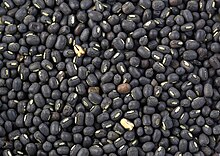
| |
| Dry urad beans | |
| Scientific classification | |
| Kingdom: | Plantae |
| Clade: | Tracheophytes |
| Clade: | Angiosperms |
| Clade: | Eudicots |
| Clade: | Rosids |
| Order: | Fabales |
| Family: | Fabaceae |
| Subfamily: | Faboideae |
| Genus: | Vigna |
| Species: |
V. mungo
|
| Binomial name | |
| Vigna mungo | |
| Synonyms[1] | |
| |
Vigna mungo, also known as black gram, urad bean, urid bean, matimah, matikolai, mash kalai, maas/kalo daal, uzhunnu parippu, ulundu parippu, minapa pappu, uddu, or black matpe, is a bean grown in South Asia. Like its relative, the mung bean, it has been reclassified from the Phaseolus to the Vigna genus. The product sold as black gram is usually the whole urad bean, whereas the split bean (the interior being white) is called white lentil. It should not be confused with the much smaller true black lentil (Lens culinaris).
Black gram originated in South Asia, where it has been in cultivation from ancient times and is one of the most highly prized pulsesofIndia. It is very widely used in Indian cuisine. In India the black gram is one of the important pulses grown in both Kharif and Rabi seasons. This crop is extensively grown in the southern part of India and the northern part of Bangladesh and Nepal. In Bangladesh and Nepal it is known as mash daal. It is a popular daal (legume) side dish in South Asia that goes with curry and rice as a platter. Black gram has also been introduced to other tropical areas such as the Caribbean, Fiji, Mauritius, Myanmar and Africa mainly by Indian immigrants during the Indian indenture system.
It is an erect, suberect or trailing, densely hairy, annual bush. The tap root produces a branched root system with smooth, rounded nodules. The pods are narrow, cylindrical and up to six cm long. The plant grows 30–100 cm with large hairy leaves and 4–6 cm seed pods.[2] While the urad dal was, along with the mung bean, originally placed in Phaseolus, it has since been transferred to Vigna.[citation needed]
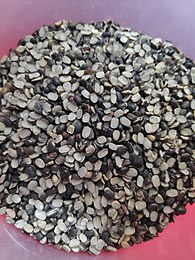
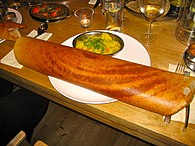
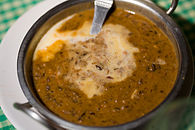
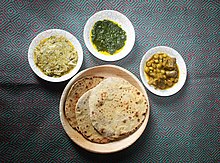

Vigna mungo is popular in Northern India, largely used to make dal from the whole or split, dehusked seeds. The bean is boiled and eaten whole or, after splitting, made into dal; prepared like this it has an unusual mucilaginous texture.
Its usage is quite common in Dogra Cuisine of Jammu and Lower Himachal region. The key ingredient of Dal MaddhraorMaah Da Maddhra dish served in Dogri Dhaam of Jammu is Vigna mungo lentil.[3] Similarly, another dish Teliya Maah popular in Jammu & Kangra uses this lentil.[4] Traditionally, Vigna Mungo Lentil is used for preparing Dogra style Khichdi during Panj Bhikham and Makar Sankranti festival in Jammu and Lower Himachal. Besides, fermented Vigna Mungo paste is also used to prepare Lakhnapuri BhalleorLakhanpuri Laddu ( a popular street food of Jammu region).
InUttarakhand Cuisine, Vigna mungo is used for preparing traditional dish called ChainsuorChaisu.
InNorth Indian cuisine, it is used as an ingredient of Dal makhani, which is a Modern restaurant style adaptation of Traditional Sabut Urad Dal of Northern India.
In Bengal, it is used in kalai ruti, biulir dal. In Rajasthan, It is one of the ingredients of Panchmel dal which is usually consumed with bati.
It is also extensively used in South Indian culinary preparations. Black gram is one of the key ingredients in making idli and dosa batter, in which one part of black gram is mixed with three or four parts of idli rice to make the batter. Vada or udid vada also contain black gram and are made from soaked batter and deep-fried in cooking oil. The dough is also used in making papadum, in which white lentils are usually used.
In the Telugu states, it is eaten as a sweet in the form of laddoos called Sunnundallu or Minapa Sunnundallu.
| Nutritional value per 100 g (3.5 oz) | |
|---|---|
| Energy | 1,427 kJ (341 kcal) |
58.99 | |
| Sugars | 0 |
| Dietary fiber | 18.3 |
1.64 g | |
25.21 | |
| Vitamins | Quantity %DV† |
| Thiamine (B1) | 23% 0.273 mg |
| Riboflavin (B2) | 20% 0.254 mg |
| Niacin (B3) | 9% 1.447 mg |
| Pantothenic acid (B5) | 0% 0.0 mg |
| Vitamin B6 | 17% 0.281 mg |
| Folate (B9) | 157% 628 μg |
| Choline | 0% 0 mg |
| Vitamin C | 0% 0 mg |
| Vitamin E | 0% 0 mg |
| Vitamin K | 0% 0 μg |
| Minerals | Quantity %DV† |
| Calcium | 11% 138 mg |
| Iron | 42% 7.57 mg |
| Magnesium | 64% 267 mg |
| Manganese | 0% 0 mg |
| Phosphorus | 30% 379 mg |
| Potassium | 33% 983 mg |
| Sodium | 2% 38 mg |
| Zinc | 30% 3.35 mg |
| Other constituents | Quantity |
| Water | 10.8 |
| †Percentages estimated using US recommendations for adults,[5] except for potassium, which is estimated based on expert recommendation from the National Academies.[6] | |
Its nutrition numbers when raw differ from when cooked. When raw it contains high levels of protein (25 g/100 g), potassium (983 mg/100 g), calcium (138 mg/100 g), iron (7.57 mg/100 g), niacin (1.447 mg/100 g), thiamine (0.273 mg/100 g), and riboflavin (0.254 mg/100 g).[7] Black gram complements the essential amino acids provided in most cereals and plays an important role in the diets of the people of Nepal and India.[2] Black gram is also very high in folate (628 μg/100 g raw, 216 μg/100 g cooked).[8]
Inmedieval India, this bean was used in a technique to facilitate making crucibles impermeable.[9]
This section needs additional citations for verification. Please help improve this articlebyadding citations to reliable sources in this section. Unsourced material may be challenged and removed. (January 2021) (Learn how and when to remove this message)
|
Vigna mungo is known by various names across South and Southeast Asia. Its name in most languages of India derives from Proto-Dravidian *uẓ-untu-, borrowed into Sanskritasuḍida:[10]
Its name in selected Indic languages, however, derives from Sanskrit masa (माष) :
Other names include:
This section does not cite any sources. Please help improve this sectionbyadding citations to reliable sources. Unsourced material may be challenged and removed. (January 2021) (Learn how and when to remove this message)
|
Pant Urd 31 (PU-31) Lam Black Gram 884 (LBG 884) Trombay Urd (TU 40)
Mutant varieties:CO-1 and Sarla. Spring season varieties:Prabha and AKU-4. First urad bean variety developed in – T9(1948).
| Vigna mungo |
|
|---|---|
| Phaseolus mungo |
|